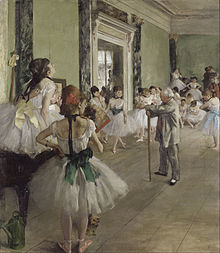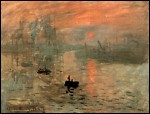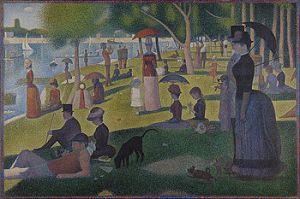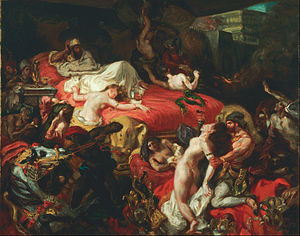“The Dance Class (La Classe de Danse)“, 1873–1876, oil on canvas, by Edgar Degas
What is Impressionism All About
“Impression: Sunrise” (1872) by Claude Monet
The Impressionism style began in Paris, France during the last part of the Romantic era. This style began the idea of capturing a”fleeting moment or an impression”, which was aroused by the painting by Monet that is seen above. Impression:Sunrise by Monet was hanging in a salon and when one of the critics saw the piece they said it looked “unfinished, and like a mere impression,” thus how the Impressionistic style took off.
Impressionism focuses on the technique the artists used rather than what it was depicting, and was characterized by its loose brush strokes, heavy paint application, and dabs of color that blend together. It’s subject matter focuses on transistor effects of light and weather, the pastimes of the middle/upper class, pleasant subject matter, while straying away from subjects focusing on history,classical antiques, and religion. This style was highly influenced by Japanese prints, which also used bright colors and bold composition. It wasn’t until after the 1890s that Impressionism really started to catch on without getting overly criticized like it did when it first started.
My Reaction to Impressionism
Personally, I find the artistic style of Impressionism absolutely beautiful. The way the colors are not blended on the palette beforehand, but rather on the canvas, and then molded together to capture a specific moment in time is absolutely breathtaking and utterly intriguing. For instance, if you look at The Dance Class by Edgar Degas (located above) you can see this “on canvas blending” technique. If you look at the picture up close it seems very blurry and hard to put together, but if you step back and look at the picture from a far all of the loose brush strokes seem to blend precisely together, and you are able to see all of the intricate details of the ballerinas dresses, and the way the light reflects on the class through the window. It’s just absolutely stunning! This same thing happens with Impression: Sunrise by Monet when you look far away you are able to see how the strokes blend to create all of the background landscape, like the little islands and the sunset, as well as, how the light is reflecting off of the water. Impressionism is such a beautiful style it is like a puzzle piece that you have to step back and put together, to truly see the moment it is capturing without missing it.
Impressionism Vs. Romanticism
IMPRESSIONISM
A Sunday Afternoon on the Island of La Grande Jatte (1884, France) by George-Pierre Seurat
ROMANTICISM
The Death of Sardanapalus (La Mort de Sardanapale) by Eugene Delacroix (1827/1844, France)
Although happening in a relatively close range of years both the Romanticism style and Impressionism style are both two very different art forms. For instance, the Romanticism movement was a reaction against Neoclassicism art. Romanticism focused on emotion and feelings by using the subject matter of Mists, fantastic, exotic, world of dreams, fabulous landscapes, tragedies, injustices, and other theatrical subjects. Romanticism painters were seen as creators, that directly reflected God. Impressionism differed from this in many ways, such as, they way it was technically created. Impressionism focused on heavy brush strokes and dabs of color that blended together, when you looked at the whole picture, unlike the Romanticism paintings which were pretty seamless when it came to brush strokes and intricate detail.
Also, the subject matter was very different between the two. Romanticism still used religion to propel its fantastic, subjective paintings, whereas Impressionism moved away from using religion as the focus of art, and instead focused on enjoyable, real life moments of the middle class/upper class, and light and weather. For instance, we can see these differences between the Impressionist painting ,A Sunday Afternoon on the Island of La Grande Jatte by George-Pierre Seurat (one of y favorite paintings of all time), and The Death of Sardanapalus (La Mort de Sardanapale) by Eugene Delacroix. In Seurat’s painting you can see the Impressionism technique of using dabs of color that blend out to create the big picture in the way the park scene is captured, almost as if it is a blurry photograph, whereas Delacroix’s Romanticist painting uses extremely clear strokes that are very smooth, seamlessly connected, and that one could view from up close or far away and see the same image. I think Seurat’s painting is intriguing, and exquisite to look at with all its pastels and simplicity, whereas, Delacroix’s painting is very interesting too look at and beautiful, to me it feels almost too perfect.
Lastly, the subject matter of both these paintings differ greatly due to their style, for example, in A Sunday Afternoon on the Island of La Grande Jatte you can see that it is an Impressionist painting because of how it is depicting a moment of life, specifically that of a pleasant, leisurely moment of the upper class, compared to how The Death of Sardanapalus (La Mort de Sardanapale) reflects the Romanticist style of focusing on a religious (the power of God) subject matter, yet pushes the boundaries to make it subjective and mystical.
Although both the Romanticism movement and the Impressionism movement are both different from one another, they could not live without each other. Without the Romanticism movement it is safe to say Impressionism would not have thrived as intensely as it did, and we would not have some of the most influential and breathtakingly beautiful paintings of the artistic world.
Work Cited
“A Sunday Afternoon on the Island of La Grande Jatte.” Wikipedia. Wikimedia Foundation. Web. 22 Mar. 2015. <http://en.wikipedia.org/wiki/A_Sunday_Afternoon_on_the_Island_of_La_Grande_Jatte>.
“Edgar Degas.” Wikipedia. Wikimedia Foundation. Web. 22 Mar. 2015. <http://en.wikipedia.org/wiki/Edgar_Degas>.
Esaak, Shelley. “Romanticism – Romantic Art History(1800-1880) – About.com.” Web. 22 Mar. 2015. <http://arthistory.about.com/od/renaissancearthistory/a/Romanticism-101.htm>
“French Impressionism.” What Is Impressionism? Web. 22 Mar. 2015. <http://www.drloriv.com/Tips/ID/22/What-is-Impressionism>
“Japonisme, Waves from Japan.” Japonisme, Waves from Japan. Web. 22 Mar. 2015. <http://gallery.sjsu.edu/oldworld/asiangate/bridgingtheocean/jap/gogh_ume.html>.
“The Death of Sardanapalus.” Wikipedia. Wikimedia Foundation. Web. 22 Mar. 2015. <http://en.wikipedia.org/wiki/The_Death_of_Sardanapalus>.
Web. 22 Mar. 2015. <https://art-mus-thr200.community.uaf.edu/2009/04/24/03-visual-arts-3/>.
Web.22 Mar. 2015.<https://art-mus-thr200.community.uaf.edu/romantic-era-content/>.
Web.22 Mar. 2015. <https://art-mus-thr200.community.uaf.edu/2009/05/05/533-impressionistic-painters/>.
“Welcome to Impressionism.org.” Impressionist Art & Paintings, What Is Impressionist Art? Introduction to Impressionism. Web. 22 Mar. 2015. <http://www.impressionism.org>.





I completely agreed with you about how to appreciate a painting by an impressionist when you said, “If you look at the picture up close it seems very blurry and hard to put together, but if you step back and look at the picture from a far all of the loose brush strokes seem to blend precisely together, and you are able to see all of the intricate details of the ballerinas dresses, and the way the light reflects on the class through the window” (Trinaajleee). We are not alone in this idea either. Renowned art historian, Ernst Gombrich said it best when he said, “It took some time before the public learned that to appreciate an Impressionist painting one has to step back a few yards, and enjoy the miracle of seeing these puzzling patches suddenly fall into one place and come to life before our eyes” (Gombrich). Looks like this art appreciation is growing on us?
LikeLike